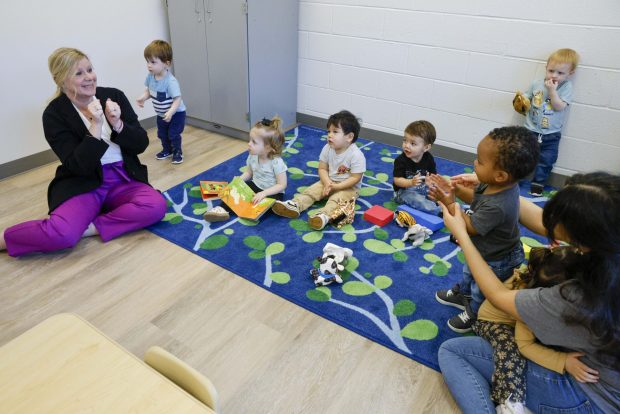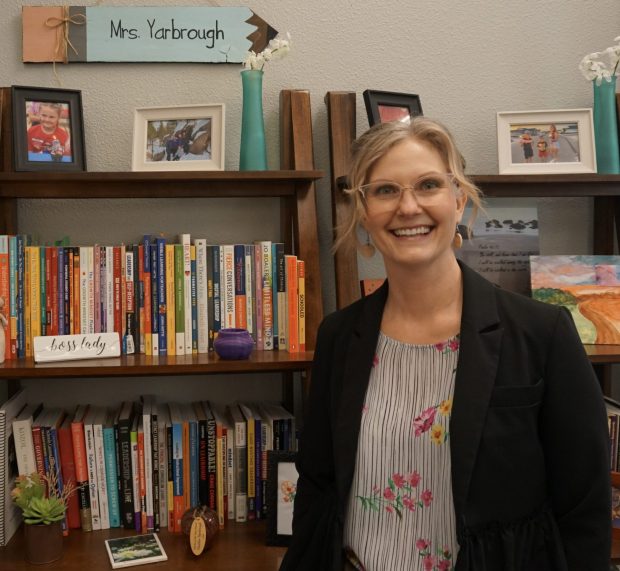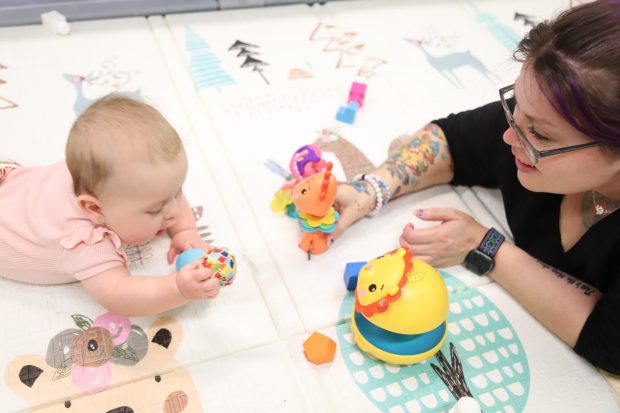This series on how the child care crisis affects working parents — with a focus on solutions — is produced by the Education Reporting Collaborative, a coalition of eight newsrooms, including The Hechinger Report, AL.com, The Associated Press, The Christian Science Monitor, The Dallas Morning News, Idaho Education News, The Post & Courier, and The Seattle Times. This is the third story; check out the first and second.
NAMPA — When Christina Zimmerman returned to teaching last year after maternity leave, she grappled with postpartum depression that she says could have led to quitting her job.
But her school’s onsite daycare made all the difference as she knew her daughter was just a few classrooms away.
“I can be mom and teacher in the same breath,” said Zimmerman, who teaches fourth grade at Endeavor Elementary in Nampa, Idaho. “I’ve dreamed of teaching since second grade. Truthfully, it’s all I’ve wanted to do, but I also want to be there for my child. Picking between the two is not something that I wanted to do.”

In states such as Idaho and Texas, where funding for early childhood education is limited, some schools are spearheading initiatives to provide quality, affordable child care. It’s a retention tool as much as it is a way to ensure youngsters are prepared when they enter kindergarten.
Some districts are transforming donated spaces — a former recycling center or house — into daycares for staff and, in some cases, for first responders in the area as well. Others are incorporating child care on their campuses.
The schools offer such programs from infancy on so that parenting teachers don’t have to make the choice between career and motherhood as that workforce remains predominantly female.
Women are more likely than men to leave their careers to care for children, data shows. On top of that, teachers’ salaries aren’t keeping up with inflation, according to the National Education Association, even as child care costs have become more untenable.
Dropping out of the workforce can be an attractive option for educators with young children, which adds to retention challenges already facing schools.
“If we’re going to support our community, … we need the very best teachers in the classroom,” Richardson schools superintendent Tabitha Branum said. Her district, just north of Dallas, runs two daycares with goals of opening more.
“This is one of the strategies that we have in place to attract and retain the very best of the best,” Branum said.

In 2022, district leaders nationwide reported increased staff vacancies; most administrators — 63% — cited the pandemic as a cause. Last school year, nearly one in four teachers said they were likely to quit their job due to stress, disillusionment, low salaries and heavy workloads, according to a RAND survey.
Advocates say school-sponsored child care works on many levels as it supports students, families and the workforce.
In Idaho, teacher moms say an onsite daycare keeps them in the classroom
The devastating feeling of dropping off her three-month-old daughter Gracee with a caregiver each day still haunts Heather Yarbrough, even 14 years later.
She cried everyday for weeks, but didn’t have the option to quit her job as an elementary reading specialist in Nampa.
Yarbrough and her husband, both educators, needed two incomes to get by financially. Over time, she realized that having a career was healthy for her and her family.
That brought her to a eureka moment: “Why do we have to choose? There’s got to be a better way,” she said.

Now Endeavor’s principal, she spearheaded an on-campus daycare. Funded through a combination of grant dollars and parent fees, the program is in its fourth year. It’s become a recruitment and retention tool for the district, which doesn’t pay teachers as much as neighboring districts.
A dozen of the school’s 30 teachers use the daycare.

Child care for school employees has trickle-down benefits for students, said Van-Kim Lin, an early childhood development researcher at Child Trends, a national research and advocacy nonprofit.
The kids can build stronger relationships with educators, counselors or other staff members because turnover is minimized and the youngsters are on campus sooner.
“This is a great strategy by which you can … support both children, families and then also on the flip side, districts and their workforce,” she said.
As Molly Hillier, an instructional coach at Endeavor and mother of a child in the daycare, put it: “it benefits students because if you have happier teachers… they can pour that into the kids.”

The school’s teaching staff is predominantly young and female, partly because the school frequently hosts student teachers, who often go on to accept jobs at the campus.
That educator pipeline model solves a recruitment problem but doesn’t help with retention. For years, multiple teachers dropped out of the workforce to care for their infants or to move on to less stressful or higher paying jobs.
In Nampa, teachers start out earning about $44,000 and top out at about $69,000 as compared to a range of about $47,000 to $86,000 in the nearby Boise School District.
But “Nampa School District right now can offer me something nobody else can,” Zimmerman said. “That time with my child is invaluable — it’s worth its weight in gold.”

In Texas, school daycare is “a dream come true” for women in education
When Kelly Mountjoy decided she wanted to start a family, she wondered if she could handle working and being a mother.
She invested years into her career as a school counselor, but it was also important to her to be a mom.
Three children later, she and her husband considered expanding their family by one more. However, the costs would add up as she was already paying more than $1,200 a month to send one of her kids to daycare. So they hesitated.
“It’s just so impossible to pay child care with that many kiddos,” said Mountjoy, who works at Parkhill Junior High in Richardson ISD.
Texas school officials, frustrated with failed legislative attempts to fund teachers raises, began in recent years unfolding strategies to recruit and retain teachers amid high turnover that was aggravated by the pandemic and other stressors.
Large districts with bigger budgets offered higher pay while others experimented with four-day school weeks or other benefits to sweeten the job.
Richardson was among the latter.

RISD’s turnover rate last school year was 21.4%, up nearly six percentage points from about five years prior, according to state data. That closely mirrors Texas’ increased turnover rate in that time.
Branum recognized the teaching workforce is often made up of young people, some of whom are “starting a family or hope to start a family soon.”
“We may not be able to pay every teacher what we should be able to … but what if we could create a compensation package that took a little stress off of them?” Branum said.
Since 2016, more than three quarters of teachers in the state have been female, according to the Texas Education Agency. A little more than a third of Texas teachers are early in their careers with experience levels of five years or less, state data shows.
The average starting salary for Texas’ teachers sits at about $53,300, according to state data. The state’s average teacher salary is $60,717.
Richardson has a starting salary of $60,000 but is also in the highly competitive Dallas-area market. So now RISD offers employees a health clinic for acute care with a $10 copay, no insurance required; free counseling; and subsidized child care for only $350 a month.
That made all the difference for Mountjoy, who could save roughly $1,700 a month between her two youngest children.
“We could have another kid like we had wanted to,” Mountjoy said. “We could afford it.”

The district runs two child learning academies — Little Eagles and Little Mustangs — that serve more than 120 children starting at 6-weeks-old until age 3, when they become eligible for the district’s pre-K program. A portion of the cost to operate the centers is funded through monthly tuition while RISD pays the balance.
With more than 134 children on the district’s wait list as of the end of April, Branum said they’re considering at least one more center that could open as soon as next year.
Mountjoy said the perk gives her peace of mind because she knows her children receive high-quality attention.
“I know that my kids are taken care of really well,” Mountjoy said. “They know the kids individually and know their strengths and where they struggle.”
Idaho Education News data analyst Randy Schrader contributed to this story.
